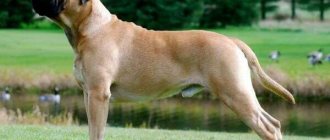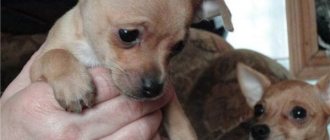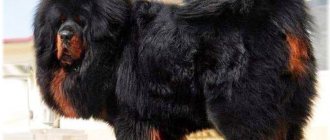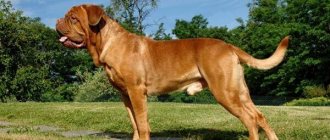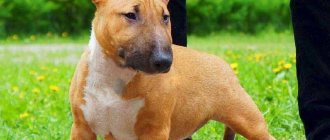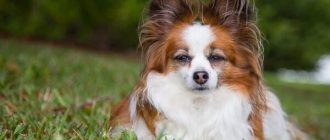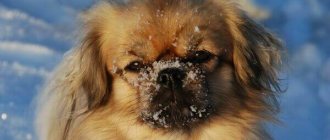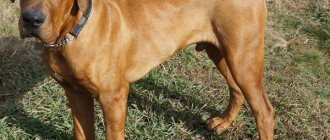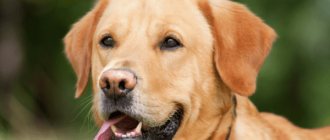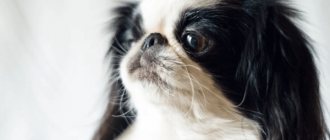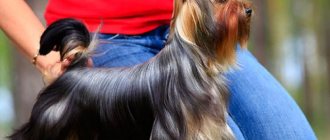Mastiffs are a name that unites a large group of breeds, which includes the English, American, Spanish, Brazilian and Major varieties, as well as the Bullmastiff and Boerboel.
The Pakistani Mastiff or Bully Kutta is also included in this group. This is an oriental dog breed.
Not officially accepted by any world association.
But this does not make the breed less popular.
Since these animals are considered good defenders and guards.
The dog is loyal and very brave.
History of the Origin of the Pakistani Mastiff or Bully Kutta
There are many theories about the origin of this breed.
One of the more logical ones is that during the conquest of the Indo-Pakistan subcontinent by Great Britain, English soldiers crossed bull terriers with local mastiffs, widely used for hunting and guarding.
The purpose of breeding the breed was to create a reliable guard and fighter.
From the Punjabi language (a dialect of the Punjab province in Pakistan), “buli” is translated as “heavily wrinkled.” "Kutta" means "dog".
Thus, the name of the breed translates as a highly wrinkled dog, which quite describes the appearance of the Pakistani Mastiffs.
History of the breed
The Bully Kut breed is very mysterious regarding history, origin, and ancestors. It is absolutely impossible to say where this species appeared, how its formation took place, and what breeds participated in it. So we have to build on existing versions and assumptions voiced by scientists and historians.
The homeland of Bully Kutta is India and Pakistan, hence the names of the breed: Pakistani, Indian Mastiff. According to one of the existing theories, the Bully Kutta originated in the Sindh province, which is why it is sometimes called the “Sindh Mastiff.”
The beginning of the history of the Bully Kuta breed is lost in the distant past, during the time of the Persians. These huge dogs were used in military battles and as guard dogs and bodyguard dogs.
In 500 BC, Bully Kutta were brought to Europe. To be precise, this type of animal came to Greece as part of the army of Xerxes.
The ancient ancestors of modern Pakistani mastiffs differed significantly in appearance. The breed has changed as a result of breeding work. When the British conquered India, they brought dogs from their homeland to the occupied territories. These were English mastiffs, English bull terriers and several hunting species.
Indian mastiffs were crossed with the English breeds listed above. Breeders had to improve the breed as much as possible. As a result, the exterior changed, physical capabilities increased, and attachment to the owner increased. But the Bully Kutta remained a dangerous, powerful, aggressive dog that required strict control and management.
To date, no association in the world has officially recognized the Bully Kutta breed.
Representatives of the breed are not widespread; their main population is found in India and Pakistan.
Description of the breed and what it looks like in the photo
The Pakistani Mastiff is classified as a Molosser. This is a large dog, has a well-developed chest, powerful skeleton and strong muscles.
The height of representatives of the breed ranges from 76 to 112 cm, weight ranges from 65-90 kg . Therefore, if during games an animal jumps on its owner, it is almost impossible to withstand it.
Regardless of the general color, they have a black muzzle, although the presence of pigmentation on the tip of the nose is considered normal . The tail is long, gradually narrows, and is lowered when at rest.
During excitement, the tail never lies on the back.
It has long legs and strong joints, the latter due to its large size . There is excellent shock absorption power, manifested in the form of wide, round feet with hard pads. The coat is short and hard.
Description
Like other mastiffs, the Pakistani is very massive and is valued as a fighting dog; no attention is paid to its exterior. When these dogs were hunters and guards, they were larger in size.
To add agility and endurance, breeders reduced the height at the withers from 90 cm to 71–85 cm, and the weight to 64–95 kg.
The head is large, with a wide skull and a muzzle, the length of which is half the length of the head. Small, erect ears are located high on the head and give it a square shape. The eyes are small and deep-set, attentive.
The coat is short, but double. The guard coat is hard and thick, lying close to the body. The undercoat is short and dense.
The color can be any, since breeders do not pay attention to the exterior, focusing only on the working qualities of the dogs.
Character traits
The main features of the Pakistani Mastiff are considered to be the following::
- courage;
- devotion;
- great willpower.
But, despite these positive features, animals are quite difficult to control, so training is carried out from an early age.
If you get a Bully Cutt, he will need to prove who is the boss in the house, only then will the pet be able to look at his owner as an equal, and not down on him.
The main purpose of representatives of this breed is protection, so the animal is sensitive to any noise and can show aggression towards strangers.
If the Pakistani Mastiff lives in the city, then during walks he must be kept on a leash and equipped with a muzzle. Otherwise, there is a risk that the animal will misperceive city noise and come to the owner’s defense right on the street.
In situations where other pets live in the house, the Pakistani Mastiff most often treats them neutrally, but if aggression is shown towards him, the dog can easily injure another pet.
The dog is considered patient and calm, but it is characterized by sudden mood swings, so having this animal in a house where children live is not the best idea.
Expert opinion
Kozhevin Semyon Kirillovich
Expert dog handler.
Pakistani Mastiffs not only have an impressive appearance, but also a dominant behavior; they are too proud. They are absolutely fearless and ready to protect their owners from any danger. The breed is intellectually developed, so Bully Cutts almost never act on instinct alone. Very loyal and dedicated.
Signs that disqualify a breed
Since there is no breed standard, it is difficult to judge traits that are not typical for the Bully Cutta. But scientists still highlight two features:
- phlegmatic behavior at an early age. If the puppy is inactive and differs from others in its docile character, then it is immediately discarded. On the streets of Pakistan, discarded bully cutta puppies that do not match the breed are quite common.
- tail lying on the back;
- overbite (bad bite).
As a rule, the Bully Cutta has floppy ears, but dogs that take part in fights have them cropped.
Advantages and disadvantages
Pakistani Mastiffs have a number of advantages:
- fearless;
- loyal to the owner;
- have a balanced psyche;
- good guards and defenders.
But against the background of these advantages, the breed also has several disadvantages.:
- independent - in the absence of timely training, they will not perceive the owner as an equal;
- do not get along with children;
- Due to its large size it is difficult to keep in an apartment.
For several centuries, these dogs lived side by side with humans.
..., thanks to which they were domesticated as much as possible and ready to serve as a home guard, protector, and hunting companion.
In hunting, bully kutta showed themselves to be stable and courageous, so they were taken to hunt large game. The dog was not afraid of buffalos, bears, tigers and other large animals, so it did not retreat, helping the man defeat the prey.
The strength of Bully Kutta dogs interested fans of dog fights, therefore, until they were banned, this breed of dog was a frequent participant in them.
This breed has strict criteria by which the breed is recognized as a purebred. Experienced specialists do not allow marriage and mixing in this breed, so it is quite rare.
Is it suitable for living in an apartment? On the street?
It is not advisable to keep representatives of Pakistani Mastiffs in an apartment, since such conditions can become a real test for the animal.
These dogs need personal space and daily exercise; walks should last between 2 and 3 hours..
An animal can be kept outside the city by providing it with a free enclosure and access to a yard. The pet feels great in the enclosure even in the winter season.
Reproduction and lifespan
It is extremely rare for Bulli Kutta to live to be 12 years old. On average, they live no more than 8-9 years. If a dog is well and properly cared for, it will serve its owners faithfully. Large dogs are bred when they are at least 2 years old.
Previously, it was impossible. It is also not recommended to breed mature dogs over 7 years old. The best time for mating is the 3rd day from the day the female starts estrus. If she happens to a male during this period, she will probably become pregnant.
How to properly care?
Representatives of the Bully Cutta breed are quite picky in grooming, and are quite capable of taking care of themselves..
Pakistani Mastiffs are short-haired animals, so there is no need to trim them. Occasionally, you can only clean the coat with a brush with hard bristles.
These dogs are almost never bathed, using wet towels as an alternative . If the dog itself wants to splash in the water, then there is no need to stop it, this will not bring any harm to the pet.
The ears, eyes and teeth of Pakistani Mastiffs are not particularly looked after. The dog's ears are small, so they are almost never exposed to diseases; they only need to be cleaned of wax with cotton swabs every few months.
And eye care consists only of timely removal of secretions.
NOTE!
Due to biological resistance to disease, the teeth of this breed are also in good condition. They can be cleaned every few months using a special dog paste.
Bully Cutts need regular daily walks, during which the pet owner should always walk in front, showing the dog which of them is the leader.
Maintenance and care
Keeping a Pakistani Mastiff in an apartment will result in a difficult ordeal for both the pet and its owner. Such large, wayward and aggressive dogs are not meant to live in a house, much less an apartment. City life is not suitable for a mastiff.
The ideal conditions required for Bulli Kutte are a private country house with a garden plot. On the site, build a spacious enclosure and a large insulated booth for the mastiff.
It is important that such a dog receives sufficient physical activity. Daily walks are required in the morning and evening, with a total duration of at least three hours.
Caring for a bully cutta does not take much time, the main thing is to do everything correctly and on schedule:
- Once every 7-8 days we comb the coat of the Sind Mastiff with a brush, cleaning and removing dead hairs.
- Instead of bathing, it is recommended to wipe your pet with a damp towel. A towel or napkins will also be needed to wipe the Pakistani's face and chest, as he tends to drool a lot.
- To clean teeth, we buy special bones at a veterinary pharmacy or give them hard fruits. You can use a brush and paste, but it is difficult to accustom your pet to this procedure.
- The nails usually wear down on the road surface; if this does not happen, you need to trim them with a nail clipper designed for large dogs.
- We clean our ears once a week and examine them. If we notice signs of infection or injury, contact a veterinarian.
To maintain a pet like a bully cutta, you will need to spend quite a lot of money. Not only is a puppy of this breed very expensive, but then you will have to buy food in fairly large quantities for a large, active dog.
If the feeding method is artificial, we buy high-quality food from trusted sellers. At the same time, the dog drinks a lot of water; the drinking bowl must be filled constantly.
With a natural feeding method, 65-75% of the Bulli-Kutta’s diet is protein food. This includes meat, offal, eggs, cottage cheese, fish (sea), kefir. The remaining 25-35% of the diet is porridge, vegetables, and fruits.
It is recommended to feed adult mastiffs 2 times a day. It is important to calculate portions correctly so as not to overfeed or undereat.
Nutritional features - what is best to feed?
Not everyone can afford to buy a Bully Cutt puppy, as this entails high food costs.
This is explained by the fact that the main diet of puppies consists of protein foods, including:
- beef and pork meat;
- cottage cheese;
- kefir;
- sea fish.
The consumption of these products has a positive effect on the puppy’s immune system and strengthens its musculoskeletal system..
An adult representative of the breed needs even more food than a puppy. During the day, the Pakistani Mastiff should be fed 2-3 times.
The diet includes:
- various cereals;
- flour products;
- potato;
- pasta;
- fresh meat.
Health
The average lifespan of a bully cutt is about 10-11 years. By nature, Pakistani mastiffs are blessed with good health; they have a strong immune defense of the body. Therefore, they rarely get sick.
The predisposition of these dogs to the following diseases has been noted:
- Dental problems – tartar, caries, periodontal disease. Regular brushing of teeth and sufficient amounts of vitamin and mineral supplements will help to avoid such problems.
- Hip dysplasia - at the first stage it manifests itself with pain, lameness, at the last stage it threatens complete immobility and unbearable pain.
- Allergic reactions - most often occur to dog care products, food allergies are less common.
In order to detect the disease in time, approximately once every 3 months you need to take your Pakistani dog to a veterinarian for preventive examinations. Routine vaccination, deworming and treatment for skin parasites are also required.
How to choose bulli kutta?
The opportunity to purchase a Bully Kut puppy is available only in India or Pakistan; in other countries this breed is not available for free sale.
Recently, Great Britain has also started breeding Pakistani mastiffs, so this breed of dog will soon be available for purchase in the territory of this country..
When choosing a puppy, you should make sure that it is healthy, although diseases in this breed are quite rare. The dog must be at least 2 months old.
It is recommended to purchase from shelters or nurseries, where a guarantee is given that it is a purebred representative of the breed..
Price
There are very few purebred representatives of this ancient breed in Russia. In the vast majority of cases, breeders pass off bully mixes as purebred mastiffs, and they ask for a decent amount of money for them, from 50 thousand rubles.
If you want to purchase an absolutely healthy and “correct” dog of this breed in all respects, we advise you to go for it to its homeland, that is, to Pakistan. There they will ask for at least 30-40 thousand for it. The price of bulli kutta in other countries of the world can reach 60 thousand rubles.
Interesting Facts
There are several interesting facts about the Bully Cutta breed that you should familiarize yourself with:
- this breed is in fourth place in the ranking of the strongest dogs;
- such dogs are regularly used in combat;
- Breeding Bully Cutta is prohibited in the Netherlands and England.
Bully Cutta is a popular breed that is often used to guard a summer cottage or private home. Before purchasing such a dog, you need to familiarize yourself with its description and how to properly care for it.
General information and breed standards: color and appearance
White color is the most common color of mastiffs.
The breed standard has the following distinctive features:
- Dimensions. You can distinguish Bully Kutta from representatives of other breeds by their size. The height of such pets reaches 100-110 centimeters. At the same time, they weigh 85-95 kilograms.
- Wool. The Indian Mastiff has fairly short hair. It is hard to the touch and not very pleasant.
- Color. The most popular color is white. However, sometimes there are dogs with dark spots on the surface of the coat.
Additional Information! The coloring of the Bully Kutta varies. There are dogs with red, brown, black and even tiger fur.
Where can I get a real Gul Dong and how much do puppies cost?
There are no kennels for breeding Pakistani bulldogs. Since there are no clear standards, when buying secondhand, you also cannot be completely sure that this is a Gul Donga puppy (especially since the puppies will be identical in appearance to the Gul Terra and Billy Kuta puppies). The characteristic differences of the Pakistani Bulldog appear as they grow older - when it becomes clear that the dog is fierce, and its jaws are stronger than those of its related breeds.
Gul dongs grow quickly, this dog is only 8 months old, but he looks like an adult dog
In Russia, America, and Europe there is no statistical data on the number of Pakistani bulldogs living here. A real Gul Dong can now be bought only in countries where this breed is bred en masse - in India and Pakistan. Puppies here cost around 4600–11700 rupees (2000–5000 rubles). By the way, adult trained dogs will cost more than puppies (sometimes the price of a large dog that has won battles reaches 30,500–40,000 rupees, which is a fabulous sum by the standards of Pakistan).
The largest number of gul dongs live in Pakistan.
